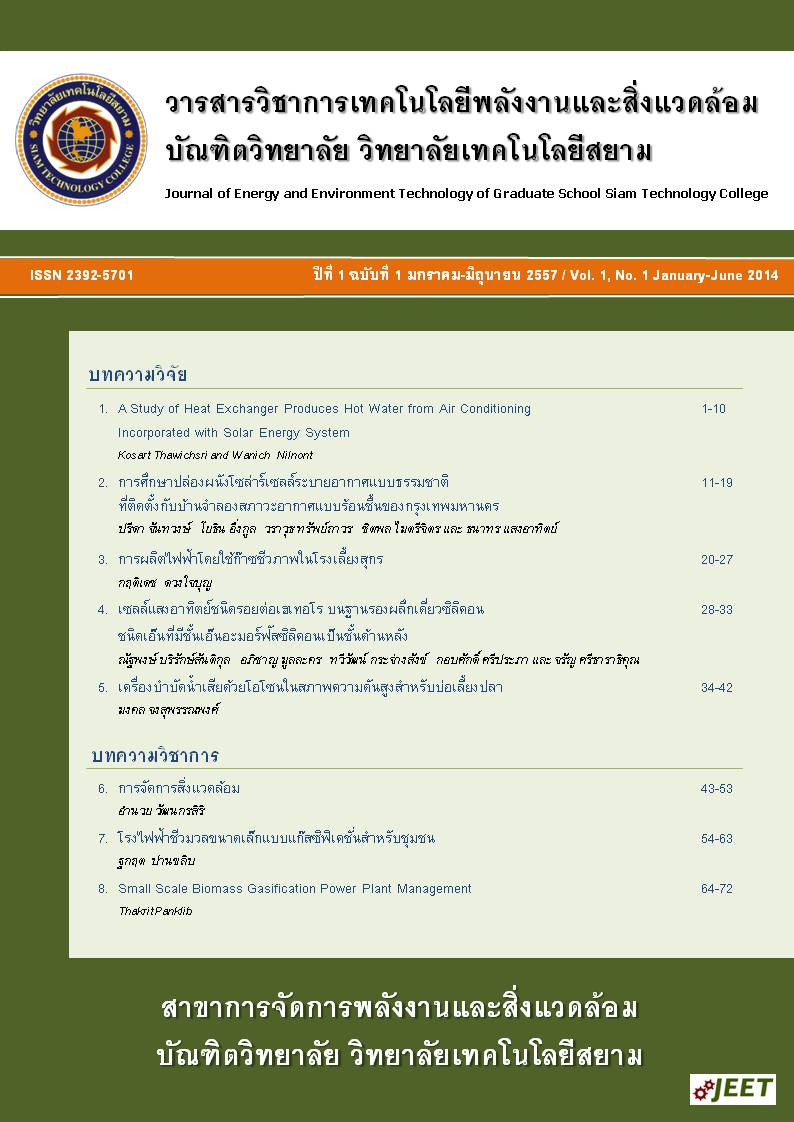Study of a Solar Cells Chimney Wall with House Model Under Hot Humid Climate of Bangkok
Main Article Content
Abstract
This paper reports experimental performance of a Solar Cells Chimney Wall (SCCW) with house model under hot humid climate of Thailand for reducing heat gain and increasing ventilation rate inside houses. The SCCW is composed of a Solar Cells panel, air gap and an inner wall made from autoclaved aerated concrete pane. Its dimensions were 1.50 m height and 0.70 m width. The thickness of the external PV panel and internal concrete wall was about 0.03 m. The SCCW gap was 0.04 m; the size of opening located at the bottom (room side), for increasing ventilation was installed in 0.24 x 0.12 m2, On the top of Solar Cells panel for insect protection was installed in 0.24 x 0.12 m2 opening to exhaust hot air to ambient. The SCCW was integrated into the south façade of a small house 4.05 m3 volume made from autoclaved aerated concrete the thickness 10 cm. Comparison between SCCW and simple concrete wall (SW) using another small house model of the same dimensions was also studied. The experimental results revealed that indoor temperature of SCCW room was lower than that of the single concrete wall room. SCCW induced ventilation rate varied following the intensity of solar radiation. This ventilation reduced heat gain admitted through the south wall considerably.
Article Details
เนื้อหาและข่อมูลในบทความที่ลงตีพิมพ์ในวารสารวิชาการ เทคโนโลยี พลังงาน และสิ่งแวดล้อม บัณฑิตวิทยาลัย วิทยาลัยเทคโนโลยีสยาม ถือเป็นข้อคิดเห็นและความรับผิดชอบของผู้เขียนบทความโดยตรง ซึ่งกองบรรณาธิการวารสารไม่จำเป็นต้องเห็นด้วย หรือว่าร่วมรับผิดชอบใด ๆ
บทความ ข้อมูล เนื้อหา รูปภาพ ฯลฯ ที่ได้รับการตีพิมพ์ในวารสารวิชาการ เทคโนโลยี พลังงาน และสิ่งแวดล้อม บัณฑิตวิทยาลัย วิทยาลัยเทคโนโลยีสยาม ถือเป็นลิขสิทธิ์ของวารสารวิชาการ เทคโนโลยี พลังงาน และสิ่งแวดล้อม บัณฑิตวิทยาลัย วิทยาลัยเทคโนโลยีสยาม หากบุคคล หรือหน่วยงานใดต้องการนำทั้งหมด หรือส่วนหนึ่งส่วนใดไปเผยแพร่ต่อ หรือเพื่อกระทำการใด ๆ จะต้องได้รับอนุญาต เป็นลายลักษณ์อักษรจากวารสารวิชาการ เทคโนโลยี พลังงาน และสิ่งแวดล้อม บัณฑิตวิทยาลัย วิทยาลัยเทคโนโลยีสยาม เท่านั้น
References
[2] กานต์ สุขสงญาติ และคณะ. “การศึกษาเปรียบเทียบเชิงเศรษฐศาสตร์ระหว่างบ้านที่ใช้ผนังอิฐมอญกับผนังมวลเบาด้านการถ่ายเทความร้อนและคุณสมบัติทางความร้อน”, วารสารวิชาการพระจอมเกล้าพระนครเหนือ, ปีที่ 17, ฉบับที่ 2, พฤษภาคม – สิงหวาคม 2550. หน้าที่ 11-20.
[3] Zalewski, L., et al, 1997. Experimental thermal study of a solar wall of composite type. Journal of Energy and Building, Vol. 25, pp. 7-18.
[4] Jie, J., et al, 2007. PV – Trombe wall Design for Buildings in Composite Climates, Journal of Solar Energy Engineering, November 2007 Vol. 129, pp. 431- 437.
[5] Khedari, J., et al, 1998. The Modified Trombe wall: A simple ventilation means and an efficient insulating material. The International Journal of Ambient Energy, Vol. 19, No. 2, pp.104-110.
[6] ปรีดา จันทวงษ์ การศึกษาทดสอบสมรรถนะทางความร้อนของปล่องผนังคอนกรีตมวลเบาระบายอากาศพลังงานแสงอาทิตย์ภายใต้สภาวะอากาศแบบรร้อนชื้นของกรุงเทพมหานคร วารสารวิศวกรรมศาสตร์ มหาวิทยาลัยสยาม ปีที่ 10 ฉบับที่ 1 เล่มที่ 18 มกราคม– มิถุนายน 2552. หน้าที่ 1-14.
[7] ปรีดา จันทวงษ์ การศึกษาสมรรถนะทางความร้อนของปล่องผนังโซล่าร์เซลล์ระบายอากาศแบบธรรมชาติภายใต้ภูมิอากาศแบบรรอนชื้นของกรุงเทพมหานคร วารสารวิชาการพระจอมเกล้าพระนครเหนือ
[8] ปีที่ 19 ฉบับที่ 2 พฤษภาคม – สิงหาคม 2552. หน้าที่ 200-208.
[9] ปรีดา จันทวงษ์ การศึกษาปล่องผนังโซล่าร์เซลล์ระบายอากาศแบบธรรมชาติร่วมกับพัดลมกระแสตรงภายใต้สภาวะอากาศของกรุงเทพมหานคร วิศวสารลาดกระบัง ฉบับที่ 26 เล่มที่ 3 กันยายน 2552 หน้าที่ 37-42.


